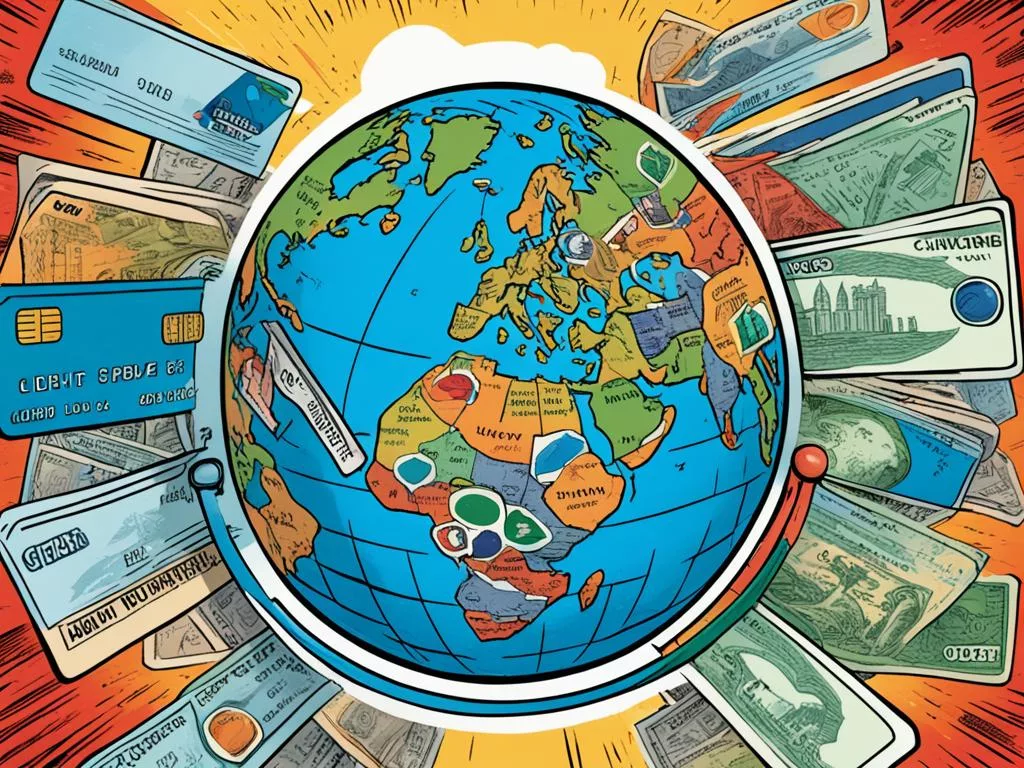As I once wrestled with an invoice from a valued overseas supplier, the numbers glaring back at me served as a stark reminder that affordability in international dealings isn’t just about the listed price—it’s about savvy payment choices. Navigating the high transfer fees that UK banks often apply1, a staggering up to £30 for every international transaction1, can be a sobering experience for businesses working towards cost efficiency. That moment taught me that exploring affordable international invoice payment options isn’t just wise; it’s imperative for sustainability and growth.
Stumbling upon methods like Telegraph Media Group International Business Money Transfer which offers the sweet relief of zero transfer fees1 proved to be a game-changer. It made me question—the pursuit for budget-friendly ways to settle international invoices, could it be less arduous?
Discovering the variety of economical methods for settling international invoices brought a new perspective on handling business funds. For instance, the use of Letters of credit (LCs) stands out for their security, safeguarding both the buyer and the exporter2. Meanwhile, an open account transaction thrills importers with its friendly cash flow impact and reduced costs, albeit at a higher gamble for exporters due to potential payment delays2. And then there’s the allure of consignment’s promise to amplify competitiveness by cutting direct costs, despite the risks an exporter takes, hoping the foreign distributor will deliver sales2.
Focused firmly on nurturing partnerships and fortifying my company’s financial foothold, I’d like to share how selecting the right payment methods has been nothing short of a cornerstone for success. Let’s uncover together how these affordable pathways can elegantly weave through the financial fabric of overseas transactions, easing the strain on your budget while assuring peace of mind.
Understanding the Complexities of International Payments
When delving into the intricacies of settling international invoices, one quickly encounters a labyrinth of costly fees, perplexing exchange rate markups, and dreaded processing delays. As cross-border payments are projected to surge from almost $150 trillion to over $250 trillion by 20273, it becomes evident that finding frugal ways to pay international invoices is not a mere convenience but a necessity for maintaining a competitive edge. This economic tectonic shift is further intensified by small businesses, NGOs, and individuals who often face more significant challenges in sending small or sporadic payments due to the involvement of numerous actors in one transaction and the prevalence of correspondents in the clearing and settlement of these payments4.
The advent of digitalization in financial services offers some relief with emerging cost-effective solutions for paying international invoices. Yet, barriers persist, particularly for new entrants with groundbreaking models, stunted by limited access to electronic payment instruments in developing countries4. With the G20 prioritizing the enhancement of cross-border payments by addressing fragmented data formats and antiquated technology platforms in 20203, there’s a glimmer of hope for more streamlined and low-priced international invoice payment alternatives.
Moreover, modern payment services like Jeeves Pay introduce an elevated level of transparency in international transactions, a welcome change from traditional systems where costs can be up to 10 times higher and take days longer compared to domestic payments3. These platforms provide a multifaceted approach to payments, incorporating swift transfers with transparent fees and an assortment of currencies to minimize expenses and optimize the payment process.
- Awareness and adjustment to the hidden complexities inherent in cross-border payments.
- Adoption of innovative payment methods that offer comprehensive transaction clarity.
- Advocacy for international payment system reforms aimed at cost, speed, access, and transparency improvements.

Finding low-priced international invoice payment alternatives is not simply about cost-saving; it taps into the necessity to follow a trajectory that aligns with global economic flows, technological improvements, and market demands. The task at hand for businesses is to navigate this elaborate ecosystem thoughtfully, sidestepping the pitfalls of traditional methods in favor of more modern, agile solutions that promise both efficiency and financial prudence.
Direct Bank Account Transfers: Pros and Cons
When considering thrifty solutions for international invoice payments, direct bank transfers often come to mind due to their widespread acceptance. However, the convenience and recognition of this method come with a spectrum of costs and speeds that can impact the bottom line of businesses seeking low-cost international invoice payment methods. My examination of bank transfers versus digital payment providers sheds light on the practicality of each option.
SWIFT payments, for instance, could take anywhere from 3 to 5 days to process5, which can pose a dilemma for time-sensitive transactions. Furthermore, the cost of these international wire transfers can be significant, sometimes escalating from $10 to $35, not including potential intermediary bank fees5. This often makes bank transfers feasible only for larger invoices, where the hefty fees become a smaller percentage of the total cost.

Conversely, as I explored 5 cheap ways to pay international invoices, I found that Wise presents a compelling case for internationally minded individuals and businesses. Wise offers international transfers to more than 80 countries and supports over 50 currencies with the advantage of receiving funds like a local in 10 different currencies5. Impressively, more than half of all payments through Wise are instant, and almost all payments arrive within 24 hours5. In an age where speed can be as crucial as cost, this is a critical benefit.
Equally significant is the cost-saving potential of using Wise. Unlike traditional bank transfers that often contain hidden fees, Wise has a transparent fee structure, charging only 0.5% to 2.5% in transfer fees with no intermediary fees or exchange rate markups5. Considering that over 70% of Wise’s transfers arrive within an hour, and 90% within a day, the company’s services could dramatically cut down the time and expenditure associated with international invoice payments5.
To round off my comparative analysis, regulatory compliance and security cannot be overlooked. Wise’s authorization by FinCEN to operate as a Money Services Business ensures that its low-cost international invoice payment methods adhere to stringent regulatory standards, offering users peace of mind regarding their financial transactions5.
In conclusion, while direct bank account transfers hold their ground in some scenarios, emerging digital payment solutions like Wise are changing the landscape for international transactions, providing faster, cheaper, and more transparent alternatives. It’s these factors that make platforms like Wise invaluable as part of my thrifty solutions for handling international invoice payments.
The Power of Credit Cards in International Commerce
In the arena of global trade, credit cards play a pivotal role, allowing businesses and individuals to manage their international financial transactions with both ease and speed. The appeal of credit cards as affordable international invoice payment options cannot be overstated. With their inherent convenience and immediate processing capabilities, they offer an inexpensive way to handle international invoice payments, particularly beneficial for less sizable transactions.
The advent of the modern credit card system, originating from early iterations like the Charga-Plate and later the Diners Club card, has led to an explosion in accessibility to credit6. In the United States, a staggering 72.5% of adults have at least one credit card6, signifying the widespread adoption of this payment method. Such cards featuring 16-digit numbers, smart card technology, and security codes, have reshaped how we engage in commerce6.
When discussing 5 cheap ways to pay international invoices, leveraging the perks of credit cards, such as rewards or cashback, can assist in offsetting the costs of international transactions. However, it’s essential to remain vigilant, as some vendors may transfer their credit card processing fees directly to clients, potentially adding to overall expenses.
- Percentage-based fees for credit card transactions typically range from 3-5%.
- Rewards and cashback programs can provide financial rebates against transaction fees.
- Smart card technology with embedded computer chips enhances security during transactions.
- Understanding vendor policies on credit card fees can prevent unexpected costs.
To illustrate the power of credit cards within today’s commerce framework, let’s examine their role through the prism of data:
| Statistic | Impact on International Transactions |
|---|---|
| 7.753 billion global credit cards as of June 20186 | Indicates ubiquitous nature, facilitating a broad acceptance worldwide |
| 1.09 billion credit cards in circulation in the U.S. as of 20206 | Reflects high prevalence in a major global economy, setting a precedent for others |
| Typical credit card size following ISO/IEC 7812 standard6 | Ensures consistency and ease of use across different international platforms |
| Global decline in U.S. dollar reserves from 71% in 2000 to 60% in 20217 | Signals a need for diverse currency transaction options like credit cards |
From providing an affordable international invoice payment option to navigating the complexities of currency exchange, credit cards endow users with an advantageous tool in the pursuit of inexpensive ways to handle international invoice payments. As such, they remain a keystone in the edifice of international commerce, empowering seamless economic engagement across borders.
Alternative Methods and Platforms for Paying Overseas Invoices
In my quest for frugal ways to pay international invoices, I’ve discovered that leveraging platforms like Wise (formerly TransferWise) can significantly reduce costs. Wise offers the advantage of low fees and the convenience of real-time exchange rates, making it a go-to for many businesses seeking budget-friendly ways to settle international invoices. Moreover, their transparent fee structure eliminates the surprise charges often seen with other services, ensuring I know exactly what I’m paying upfront.8
PayPal is another platform I’ve used frequently for its ease of use and immediate transactions. While fees can accumulate, especially when accepting credit and debit card payments through their platform, PayPal remains a trusted choice for many small businesses and individuals needing to pay smaller amounts quickly and securely. This is particularly advantageous when considering the rapid processing times of the Faster Payment Service (FPS) they offer, which contrasts with the typical three-working-day clearance that BACS payments require.9
Additionally, as I look for 5 cheap ways to pay international invoices, I can’t ignore mobile payments, which allow for swift, secure transactions at my fingertips. These payment methods, often accompanied by biometric authentication, provide a streamlined process without the transaction costs associated with card payments. For larger or recurring payments, I find that wire transfers and ACH payments are more suitable, though one must remain cognizant of the potential fees and processing times that can vary depending on the method chosen.10
Ultimately, the most economical method for paying overseas invoices hinges on the invoice amount, urgency, and the geographical location of the supplier. My experience has taught me the importance of researching and comparing the costs, speed, and coverage to ensure I choose the most cost-effective option for my international payment needs. In doing so, I am better equipped to manage my business expenditures without compromising on reliability or convenience.
Source Links
- https://www.telegraph.co.uk/financial-services/currency-exchange/international-money-transfers-business/how-to-pay-an-international-invoice/
- https://www.trade.gov/methods-payment
- https://www.bankofengland.co.uk/payment-and-settlement/cross-border-payments
- https://www.bis.org/cpmi/publ/d173.pdf
- https://wise.com/us/blog/wise-vs-international-bank-transfers
- https://en.wikipedia.org/wiki/Credit_card
- https://www.federalreserve.gov/econres/notes/feds-notes/the-international-role-of-the-u-s-dollar-20211006.html
- https://www.irs.gov/individuals/international-taxpayers/foreign-electronic-payments
- https://www.sage.com/en-gb/blog/invoice-cheat-sheet/
- https://www.investopedia.com/terms/p/payment.asp

